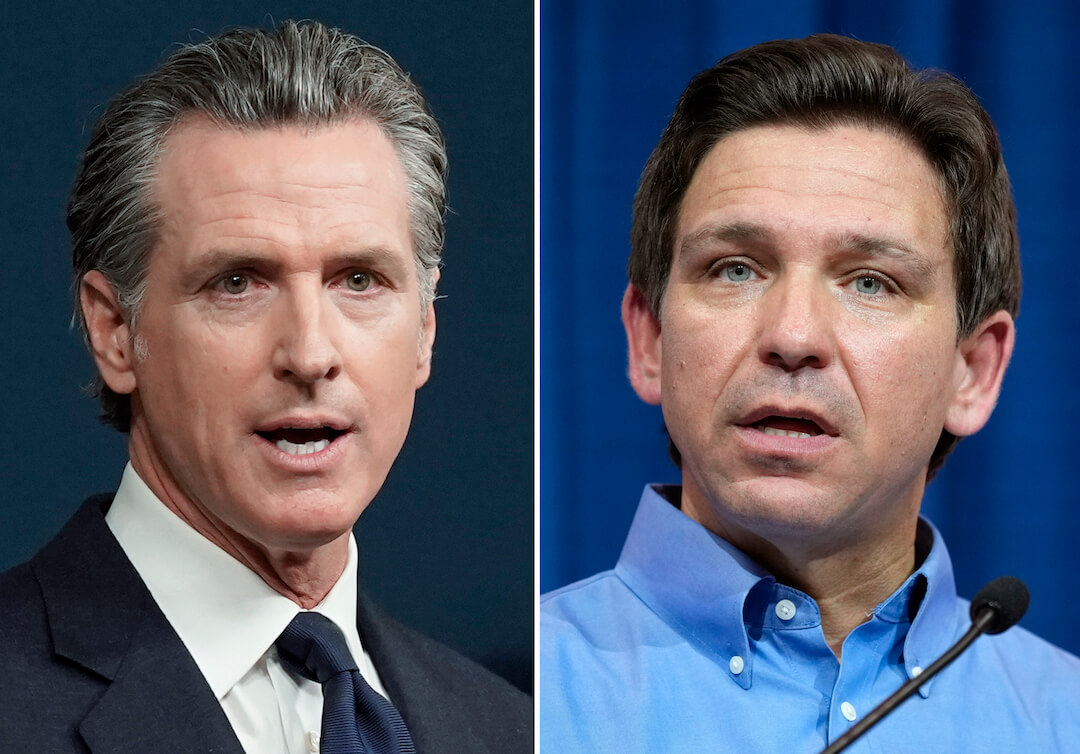Building on a Poynter Report news-avoidance item earlier this week, and the natural “here we go again” vibe to a third indictment of former President Donald Trump in one calendar year, I wanted to look at some news coverage that might stand out amid reader fatigue. Which outlets are doing the needed explanatory, democracy-saving work around the former president’s charges? Which orgs are giving these charges their needed urgency?
A third-day piece that emphasizes that how this indictment is different was The New York Times’ David Leonhardt’s newsletter yesterday morning:
“For now, you can think of the new charges as being both more important and less solid than Trump’s previous federal indictment, which involved his refusal to return classified documents. In the latest case, he was subverting the very foundation of democracy — the peaceful transfer of power after an election. Yet it remains unclear whether he broke any specific law when he tried to do so.”
This line effectively lays out clear distinctions between the previous indictments and what went down this week in Washington. It points to the nuance that special counsel Jack Smith will have to bring to his charges – the piece points to how this indictment isn’t as cut and dry as previous ones. It gives readers a map of what to expect (and what will be unexpected) in the coming weeks.
The best indictment coverage can go big picture and small picture all at once. Both explaining the major implications on democracy of this indictment and talking about what specific parts of the document mean.
I submit humbly (I work there) the policy team at PolitiFact’s work explaining the document:
“Structurally, the indictment offers a unified narrative, dividing Trump and his allies’ activities into four major phases. The activities start shortly after Election Day in 2020 and end with the storming of the U.S. Capitol, with Trump trying to enlist the aid of everyone from state elected officials to Justice Department officials and his own vice president, Mike Pence.”
At PolitiFact, we always emphasize primary documents. And our readers come to us for it. The first piece we published after the indictment was unsealed was the 45-page document in its entirety. Maybe the readers are avoidant or fatigued, but they’re not dumb. Poring over primary documents is a key part of PolitiFact’s fact-checking process, and we like for readers to have the same opportunity.
In addition to the basics on Day 1, we also put the charges in context with the news cycle the following day: What Donald Trump, Hunter Biden and Devon Archer have in common: a news cycle
I have to award The Washington Post most interesting day-of angle and best headline: Trump is charged under civil rights law used to prosecute KKK violence by investigative reporters Isaac Stanley-Becker and Spencer S. Hsu. They were ready – this story published minutes after the indictment was unsealed Tuesday night.
What a fascinating curiosity gap, one that both promises and delivers deep historical context alongside breaking news. This piece was in the top 5 of Google Trends Wednesday morning, I’m sure WaPo had tons of eyeballs on it.
“Even those who have prosecuted cases under the statute, or studied its terms, were surprised by its inclusion in the Trump indictment. It wasn’t among the offenses included in the December 2022 referral of Trump for criminal prosecution made by the House select committee investigating the Jan. 6 attack on the Capitol.”
In this news market, it’s tough competition for reader eyeballs. And a third indictment will be a litmus test for coverage that delivers to, then transcends a weary news consumer’s expectations.
What standout indictment coverage did I miss? Let me know: jhollingsworth@poynter.org
By Josie Hollingsworth
New York Times runs correction on Vietnamese language glyph removal
The New York Times ran a correction this week for faulty usage of Vietnamese, with important pieces of the language removed to fit with Times style and standards.
The original version of the essay, a literary tour through Hanoi written by Vietnamese author Nguyễn Phan Quế Mai, included diacritical marks for Vietnamese words. These glyphs are added to characters in the Latin alphabet to signify differences between similar words in translation in many languages. Leaving one out can change meaning drastically. (Spanish speakers never confuse “año” and “ano,” after all.)
In Quế Mai’s piece, the removal of diacritical marks does exactly that. “In the case of Hỏa Lò Prison, for example, ‘hỏa’ means ‘fire,’ and ‘lò’ means ‘furnace’: the Burning Furnace Prison,” she writes in the piece’s correction. “Without the marks, ‘hoa’ means ‘flowers,’ and ‘lo’ means ‘worry,’ rendering the term “Hoa Lo” meaningless. “
The New York Times policy is not a blanket ban on diacritical marks — when it comes to certain languages. A 2000 blog post states the style manual calls for accent marks in Romance languages and German only, citing the typesetting system as a limitation. A 2014 column by then-Public Editor Margaret Sullivan referred to the stylebook again, which caps the practice for “French, Italian, Spanish, Portuguese and German words and names,” with the stylebook entry saying that using such marks would be “prone to error.”
“I look forward to the day when The Times and other Western publications celebrate the richness and complexity of Vietnamese, and of all other languages, by showcasing them in their original formats,” Quế Mai closes the correction with.
It’s good to see editors give Quế Mai the space for that final note, as previous questions on the Times’ glyph usage ended in the stylebook’s gestures toward the limitations of one of the most well-funded newsrooms in the world.
By Annie Aguiar
This is debatable

California Gov. Gavin Newsom, left, and Florida Gov. Ron DeSantis. (AP Photo, File)
It sounds like a professional wrestling match.
I’ll meet you anytime, anywhere. Name the place and time!
Well, these opponents won’t be actually wrestling, but they might end up throwing verbal shots at one another. California Democratic Gov. Gavin Newsom and Florida Republican Gov. Ron DeSantis sound like they are going to debate one another.
I’m still not 100% convinced a debate will happen, but it’s tentatively scheduled for early November and will be televised by Fox News.
What’s the debate supposed to settle? After all, at the moment, DeSantis is a longshot at best to get the Republican nomination in 2024 and Newsom isn’t even running. But it’s being billed as a debate about which policies are better: blue states or red states?
The two governors have been trading barbs for quite some time. But last week, Newsom sent a letter to Fox News’ Sean Hannity laying out the rules.
Newsom proposed a 90-minute debate in a studio with no live audience and Hannity as the lone moderator. The candidates cannot have notes, but they can have a pen and paper to write down thoughts during the debate. No staff can be involved once the debate begins.
Newsom proposed two possible dates (Nov. 8 and Nov. 10) and suggested three locations: Nevada, Georgia and North Carolina.
DeSantis hadn’t committed to a debate until he was asked about it by Hannity on Fox News on Wednesday night. DeSantis said, “Absolutely. I’m game. Let’s get it done. Just tell me when and where.”
By Tom Jones
Media tidbits and links for your weekend review
- Poynter contributor Amaris Castillo this week spoke with two local reporters in Georgia on how they’ve been preparing to cover an expected indictment in the investigation into Donald Trump’s alleged attempt to overturn the 2020 election results in the state. Tamar Hallerman, a senior reporter for The Atlanta Journal-Constitution, and Stephen Fowler, a political reporter for Georgia Public Broadcasting, shared insights into their work. “It’s been the ride of a lifetime,” Hallerman said.
- Gannett and Lee Enterprises, two of the largest newspaper chains in the country, released their earnings for the most recent quarter Thursday. Both saw digital revenue grow as total revenue fell. Angela Fu has more for Poynter.
- Washington Post media reporter Paul Farhi writes about Wendy McCaw, the owner of the recently-shut down Santa Barbara News-Press: “She paid a fortune for her town’s paper. Years of turmoil followed.”
- Hat tip to Muck Rack for flagging this enthralling piece: High Country News’ Kylie Mohr with “‘We have fire all around us and we can’t get out.’ What happened when two experienced hikers got caught in the Bolt Creek Fire.”
- Even if you’re not a soccer fan, you’ll want to read this deeply personal piece written by Arsenal goalkeeper Aaron Ramsdale for The Players’ Tribune: “Oh Shut Up, Ramsdale!”
- Variety’s Kate Aurthur writes about “Succession” actress Sarah Snook in “Long Live Shiv Roy: Sarah Snook Tells All on That ‘Succession’ Ending, Her Pregnancy and Crying Through the Finale.”
- Here’s a fun piece from The Ringer’s Miles Surrey and Megan Schuster: “The Definitive Ranking of Movie Monsters.”
More resources for journalists
- Covering Climate Change Science and Policy in a Polarized World (Seminar, Washington D.C.) — Apply Aug. 14.
- Executive Leadership Summit (Oct.) (Seminar) — Apply by Aug. 14.
- Poynter Leadership Academy for Women in Media (Mar., May & Sept. 2024) — Apply by Sept. 8, 2023.
- Power of Diverse Voices: Writing Workshop for Journalists of Color (Nov. 15-18) (Seminar) — Apply by Sept. 15.
Have feedback or a tip? Email Poynter senior media writer Tom Jones at tjones@poynter.org.
The Poynter Report is our daily media newsletter. To have it delivered to your inbox Monday-Friday, sign up here.
Follow us on Twitter and on Facebook.









